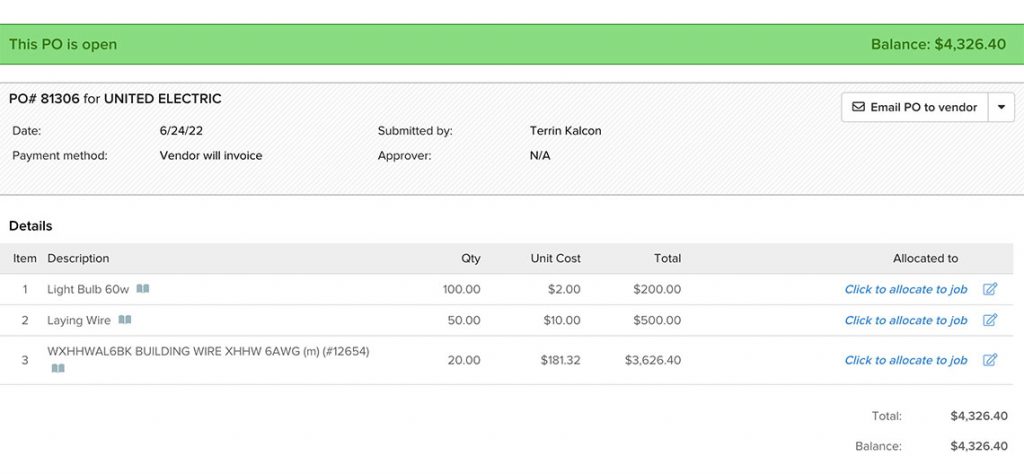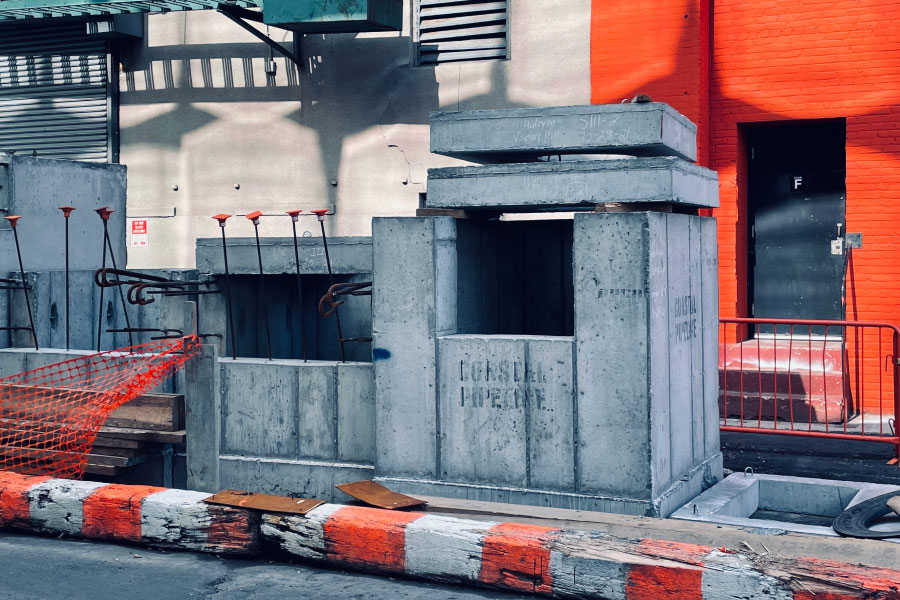As a critical part of any project, construction purchase orders serve to bind together buyers and sellers in a way that encourages trust. As a specialty contractor, you’ll likely find yourself as a buyer in most of your projects, so it’s crucial to understand the intricacies of this relationship.
In this article, we’ll take a closer look at the importance of purchase orders and the essential elements necessary for a strong, complete PO. Keep reading to learn what you need to ensure your purchase orders help lead to successful projects.
What is a construction purchase order (PO)?
A purchase order (PO) is a legally binding document submitted to a materials vendor with the intention to honor a sale. In other words, it’s a legal promise that a contractor will collect materials and pay for them in full at a later date.
Purchase orders outline the details of a given purchase, including the specific quantity and price. For example, if you estimate that you’ll need 100 units of material A, and you need them by a specific date, you’ll initiate this request through a purchase order. Once the vendor accepts the purchase order, they’ll procure the materials, deliver them, and send a bill (likely at the end of the month).
It’s important to note that a purchase order only becomes legally binding once the seller accepts the order. Once accepted, the buyer promises to honor the sale, and the supplier promises to procure and deliver the materials at the requested date, time, and quantity. In this way, a PO protects both parties, setting in stone the terms and conditions of a transaction.
When is a construction purchase order required?
You’ll use a purchase order any time you purchase supplies or materials on credit. Again, if you need to secure large quantities of materials for a specific phase of a job, a PO will be your go-to option for sourcing these materials.
You can send POs directly to suppliers, but in larger construction projects, you may have to submit your request to a general contractor or project manager first. This is done through a purchase order requisition.
After a purchase requisition is sent, your general contractor or project manager will then send the PO to the supplier for you. Either way, if you need materials to complete the job, draft a PO and inform all relevant stakeholders.
Typical PO process
Step 1: Identify a material, equipment, or service need.
Step 2: Identify a supplier or vendor that offers the materials or service you need for a price that both you and the vendor can agree on.
Step 3: Draft a purchase order that details the specifics of the material needed, quantity, price, shipment info, and timelines.
Step 4: The buyer actually sends the PO to the vendor as an official request. Subsequently, the vendor then begins to procure the materials.
Step 5: The vendor supplies the order according to the details of the PO and arranges for the delivery or pick up of the materials. After pickup, the supplier will issue an invoice at a later date.
Benefits of using construction purchase orders
The main benefit of a purchase order is that it’s legally binding. It provides legal obligation and protection for both buyers and suppliers. As with all agreements, it provides a clear paper trail that you can easily reference should any disputes or disagreements arise over price, shipment, or quality of materials.
You may feel confident in a handshake deal, especially when dealing with a supplier with whom you have a long working relationship. Even still, it’s your responsibility as a business owner to protect yourself and your money by issuing a PO.
At the same time, they also conveniently break down the details of the transaction, helping with accounting, job costing, and financing processes. POs are an essential chapter in understanding the financial story of your business. Don’t overlook them.
What do you include in a construction purchase order?
Purchase orders must include descriptions of the items, quantities, shipment/delivery information, timelines, and the price of each item. In certain situations, you may be able to leave out price, but this is only reserved for situations where vendor pricing is expected to fluctuate.
But there is a big caveat here. You must have a good relationship with the vendor and trust they’ll provide a fair price.
However, this should not be the norm; most times, you’ll want to agree on a set price and list that information on the PO.
The specifics of a purchase order will vary depending on the needs of the construction project.
A typical construction purchase order will include:
- A unique PO reference number (used for tracking and accounting purposes)
- The date you submitted the PO
- Address and business information of both the buyer and supplier
- Shipping address/ pickup location for the buyer
- Detailed line items specifying the material, product, service needed, including quantity, unit price, and price totals—this will include the agreed-upon price
- Terms and conditions, including timelines, delivery methods, etc.
Example of a purchase order in Knowify:

A better way to manage purchase orders with Knowify
Creating purchase orders and diligently tracking them has never been a fun part of the job. But with Knowify, the PO process has never been easier. In just a few clicks, you can generate and send POs directly to your vendors. Paperless, professional, efficient. Never get overwhelmed with your PO process again with Knowify.
Streamline your construction business, stay organized, and save time with Knowify Base. Create and manage proposals, contracts, change orders, and invoices, all in one place, for just $48/mo.
FAQs on purchase orders
Are purchase orders the same as invoices?
In the construction industry, purchase orders are not synonymous with invoices. Although similar, they serve two different business functions. A purchase order is an official request that goods will be exchanged and paid for.
The supplier will send an invoice after they’ve delivered the materials. The invoice will be their request to receive payment for their end of the deal. In other words, the PO kicks off the transaction, laying out all details and obligations, and an invoice brings the transaction to a close.
Difference between a purchase order in construction and a contract
For all intents and purposes, a purchase order is a “contract,” as it promises that two parties will meet the obligations outlined in the agreement. However, technically, a purchase order is not a contract in the traditional sense, even though it’s legally binding. It’s also important to note that purchase orders only become legally binding once the vendor accepts the terms of the order (i.e., price, quantity, delivery date). Still with me?
A contract is also a legally binding document, but it will set out the entirety of an agreement. It will cover all job components–including a list of all POs for a project–whereas a purchase order is a single use document that only specifies the details of a single purchase. That said, purchase orders are not a substitute for a complete contractual agreement.
